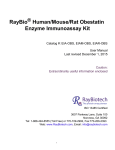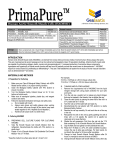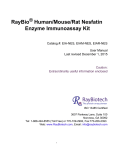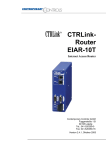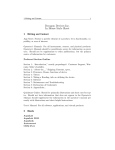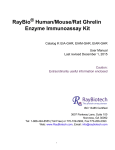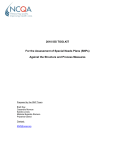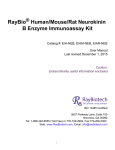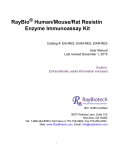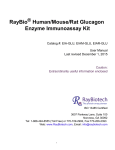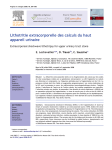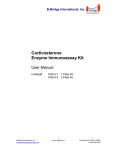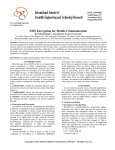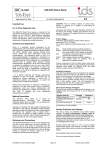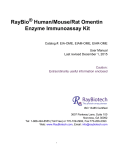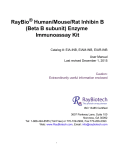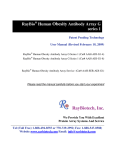Download Manual - RayBiotech, Inc.
Transcript
RayBio® Human/Mouse/Rat Angiotensin II Enzyme Immunoassay Kit Catalog #: EIA-ANGII, EIAM-ANGII, EIAR-ANGII User Manual Last revised December 1, 2015 Caution: Extraordinarily useful information enclosed ISO 13485 Certified 3607 Parkway Lane, Suite 100 Norcross, GA 30092 Tel: 1-888-494-8555 (Toll Free) or 770-729-2992, Fax:770-206-2393 Web: www.RayBiotech.com, Email: [email protected] 1 Table of Contents Section Page # I. Introduction 3 II. General Description 4 III. How It Works 4 IV. Storage 5 V. Reagents 5 VI. Additional Materials Required 6 VII. Reagent Preparation A. Preparation of Plate and Anti-Angiotensin II Antibody B. Preparation of Biotinylated Peptide (Item F) C. Preparation of Standards D. Preparation of Positive Control E. Preparation of Samples F. Preparation of Wash Buffer and HRP-Strep 6 6 7 8 9 9 10 VIII. Assay Procedure 10 IX. Assay Procedure Summary 11 X. Calculation of Results A. Typical Data B. Sensitivity C. Detection Range D. Reproducibility E. Assay Diagram 12 12 12 12 12 13 XI. Specificity 14 XII. Select Publications 14 XIII. Troubleshooting Guide 15 Please read the entire manual carefully before starting your experiment 2 I. Introduction Angiotensin, a key player in the renin-angiotensin system, is a peptide hormone that causes vasoconstriction, increased blood pressure, and release of aldosterone from the adrenal cortex. It is derived from the precursor molecule angiotensinogen produced in the liver. Angiotensin II is formed from Angiotensin I, which is removed of two terminal residues by the enzyme Angiotensin-converting enzyme (ACE). Angiotensin II acts as an endocrine, autocrine/ paracrine, and intracrine hormone. Angiotensin II is degraded to angiotensin III by angiotensinases that are located in red blood cells and the vascular beds of most tissues. It has a half-life in circulation of around 30 seconds, while in tissue, it may be as long as 15-30 minutes. The effect of obesity on Angiotensin II has recently been reported. Obese patients show heightened renal vasodilation to blockade of the renin-angiotensin system, suggesting deficits in vascular responses to angiotensin II. This may due to increased reactivity of renal vasoconstriction to ANG II. Angiotensin II has been associated with a number of important physiological processes in heart, brain, adrenal gland and kidney. For cardiovascular effect, Angiotensin II is a potent direct vasoconstrictor, constricting arteries and veins and increasing blood pressure. It is also the most important Gq stimulator of the heart during hypertrophy. For neural effects, Angiotensin II increases thirst sensation (dipsogen) through the subfornical organ (SFO) of the brain, decreases the response of the baroreceptor reflex, and increases the desire for salt. It increases secretion of ADH in the posterior pituitary and secretion of ACTH in the anterior pituitary. For adrenal effects, Angiotensin II acts on the adrenal cortex, causing it to release aldosterone. For renal effects, Angiotensin II has a direct effect on the proximal tubules to increase Na+ absorption. 3 II. General Description The RayBio® Angiotensin II Enzyme Immunoassay (EIA) Kit is an in vitro quantitative assay for detecting Angiotensin II peptide based on the competitive enzyme immunoassay principle. In this assay, a biotinylated Angiotensin II peptide is spiked into the samples and standards. The samples and standards are then added to the plate, where the biotinylated Angiotensin II peptide competes with endogenous (unlabeled) Angiotensin II for binding to the anti-Angiotensin II antibody. After a wash step, any bound biotinylated Angiotensin II then interacts with horseradish peroxidase (HRP)streptavidin, which catalyzes a color development reaction. The intensity of the colorimetric signal is directly proportional to the amount of captured biotinylated Angiotensin II peptide and inversely proportional to the amount of endogenous Angiotensin II in the standard or samples. A standard curve of known concentration of Angiotensin II peptide can be established and the concentration of Angiotensin II peptide in the samples can be calculated accordingly. III. How It Works 4 IV. Storage The entire kit may be stored at -20°C to -80°C for up to 6 months from the date of shipment. For extended storage, it is recommended to store at -80°C. Avoid repeated freeze-thaw cycles. For prepared reagent storage, see table below. V. Reagents Component Size / Description Storage / Stability After Preparation Angiotensin II Microplate (Item A) 96 wells (12 strips x 8 wells) coated with secondary antibody. 1 month at 4°C* Wash Buffer Concentrate (20X) (Item B) 25 ml of 20X concentrated solution. 1 month at 4°C Standard Angiotensin II Peptide (Item C) 2 vials of Angiotensin II Peptide. 1 vial is enough to run each standard in duplicate. The first standard: 2-3 days at 4°C Additional dilutions: Do not store Anti-Angiotensin II Polyclonal Antibody (Item N) 2 vials of anti-Angiotensin II. 1 month at 4°C 5X Assay Diluent B (Item E) 15 ml of 5X concentrated buffer. Diluent for both standards and samples including serum, plasma, cell culture media or other sample types. 1 month at 4°C Biotinylated Angiotensin II Peptide (Item F) 2 vials of Biotinylated Angiotensin II Peptide, 1 vial is enough to assay half the plate. 2-3 days at 4°C HRP-Streptavidin Concentrate (Item G) 600 µl 100X concentrated HRP-conjugated streptavidin. Do not store and reuse Positive Control (Item M) 1 vial of Positive Control. 2-3 days at 4°C TMB One-Step Substrate Reagent (Item H) 12 ml of 3,3,5,5'-tetramethylbenzidine (TMB) in buffer solution. N/A Stop Solution (Item I) 8 ml of 0.2 M sulfuric acid. N/A *Return unused wells to the pouch containing desiccant pack, reseal along entire edge. 5 VI. Additional Materials Required 1. 2. 3. 4. 5. 6. 7. 8. 9. 10. 11. Microplate reader capable of measuring absorbance at 450 nm Precision pipettes to deliver 2 µl to 1 ml volumes Adjustable 1-25 ml pipettes for reagent preparation 100 ml and 1 liter graduated cylinders Absorbent paper Distilled or deionized water SigmaPlot software (or other software which can perform four-parameter logistic regression models) Tubes to prepare standard or sample dilutions Orbital shaker Aluminum foil Plastic wrap VII. Reagent Preparation Keep kit reagents on ice during reagent preparation steps. A. Preparation of Plate and Anti-Angiotensin II Antibody 1. Equilibrate plate to room temperature before opening the sealed pouch. 2. Label removable 8-well strips as appropriate for your experiment. 3. 5X Assay Diluent B (Item E) should be diluted 5-fold with deionized or distilled water. 4. Briefly centrifuge the anti-Angiotensin II antibody vial (Item N) Then add 50 µl of 1X Assay Diluent B to the vial to prepare the antibody concentrate. Pipette up and down to mix gently. 5. The antibody concentrate should then be diluted 100-fold with 1X Assay Diluent B. This is your anti-Angiotensin II antibody working solution, which will be used in step 2 of Assay Procedure (Section VIII). Note: The following steps may be done during the antibody incubation procedure (step 2 of Assay Procedure) 6 B. Preparation of Biotinylated Angiotensin II (Item F) 5. Briefly centrifuge the vial of Biotinylated Angiotensin II (Item F) before use. 6. See the image below for proper preparation of Item F. Transfer the entire contents of the Item F vial into a tube containing 5 ml of 1X Assay Diluent B. This is your Working Stock of Item F. Pipette up and down to mix gently. The final concentration of biotinylated Angiotensin II will be 40 pg/ml. a. Second Dilution of Item F for Standards: Add 2 ml of Working Stock Item F to 2 ml of 1X Assay Diluent B. The final concentration of biotinylated Angiotensin II will be 20 pg/ml. b. Second Dilution of Item F for Positive Control: Add 100 µl of Working Stock Item F to 100 µl of the prepared Positive Control (Item M). (See section D for Positive Control preparation) The final concentration of biotinylated Angiotensin II will be 20 pg/ml. c. Second Dilution of Item F for samples: Add 125 µl of Working Stock Item F to 125 µl of prepared sample (see section E for sample preparation). This is a 2-fold dilution of your sample. The final concentration of biotinylated Angiotensin II will be 20 pg/ml. 7 C. Preparation of Standards 7. Label 6 microtubes with the following concentrations: 1000 pg/ml, 100 pg/ml, 10 pg/ml, 1 pg/ml, 0.1 pg/ml and 0 pg/ml. Pipette 450 µl of biotinylated Angiotensin II Item F working solution (prepapred in step 6a) into each tube, except the 1,000 pg/ml (leave this one empty). It is very important to make sure the concentration of biotinylated Angiotensin II is 20 pg/ml in all standards. 8. Briefly centrifuge the vial of Angiotensin II Standard (Item C). Pipette 8 µl of Item C and 792 µl of 20 pg/ml biotinylated Angiotensin II working solution (prepared in step 6a) into the tube labeled 1000 pg/ml. Mix thoroughly. This solution serves as the first standard (1000 pg/ml Angiotensin II standard, 20 pg/ml biotinylated Angiotensin II). 9. To make the 100 pg/ml standard, pipette 50 µl of the 1000 pg/ml Angiotensin II standard into the tube labeled 100 pg/ml. Mix thoroughly. 10. Repeat this step with each successive concentration, preparing a dilution series as shown in the illustration below. Each time, use 450 µl of biotinylated Angiotensin II and 50 µl of the prior concentration until the 0.1 pg/ml is reached. Mix each tube thoroughly before the next transfer. 8 D. Positive Control Preparation 11. Briefly centrifuge the Positive Control vial (Item M). 12. Refer to step 6b. This is a 2-fold dilution of the Positive Control. The final concentration of biotinylated Angiotensin II should still be 20 pg/ml. The Positive Control is a mouse serum sample sample that serves as a system control to verify that the kit components are working. The resulting OD will not be used in any calculations; if no positive competition is observed please contact RayBiotech Technical Support. The Positive Control may be diluted further if desired, but be sure the final concentration of biotinylated Angiotensin II is 20 pg/ml. E. Sample Preparation 13. If you wish to perform a 2-fold dilution of your sample, proceed to step 6c. If you wish to perform a higher dilution of your sample, dilute your sample with 1X Assay Diluent B before performing step 6c. EXAMPLE (to make a 4-fold dilution of sample): a. Dilute sample 2-fold (62.5 µl of sample + 62.5 µl of 1X Assay Diluent B.). b. Perform step 6c (125 µl of working solution Item F + 125 µl of sample prepared above). The total volume is 250 µl, enough for duplicate wells on the microplate. It is very important to make sure the final concentration of the biotinylated Angiotensin II is 20 pg/ml. Note: Optimal sample dilution factors should be determined empirically, however you may reference below for recommended dilution factors for serum: Human=2X Mouse=2X Rat=2X. If you have any questions regarding the recommendended dilutions you may contact technical support at 888-494-8555 or [email protected]. 9 F. Preparation of Wash Buffer and HRP 14. If Item B (20X Wash Concentrate) contains visible crystals, warm to room temperature and mix gently until dissolved. 15. Dilute 20 ml of Wash Buffer Concentrate into deionized or distilled water to yield 400 ml of 1X Wash Buffer. 16. Briefly centrifuge the HRP-Streptavidin vial (Item G) before use. 17. Dilute the HRP-Streptavidin concentrate 100-fold with 1X Assay Diluent B. VIII. Assay Procedure 1. Keep kit reagents on ice during reagent preparation steps. It is recommended that all standards and samples be run at least in duplicate. 2. Add 100 µl of Anti-Angiotensin II Antibody (Item N) (See Reagent Preparation step 3) to each well. Incubate for 1.5 hours at room temperature with gentle shaking (1-2 cycle/sec). You may also incubate overnight at 4ºC. 3. Discard the solution and wash wells 4 times with 1X Wash Solution Buffer (200300 µl each). Washing may be done with a multichannel pipette or an automated plate washer. Complete removal of liquid at each step is essential to good assay performance. After the last wash, remove any remaining Wash Buffer by aspirating or decanting. Invert the plate and blot it against clean paper towels. 4. Add 100 µl of each standard (see Reagent Preparation Section C), Positive Control (see Reagent Preparation Section D) and sample (see Reagent Preparation Section E) in appropriate wells. Be sure to include a blank well (Assay Diluent only). Cover wells and incubate for 2.5 hours at room temperature with gentle shaking (1-2 cycles/sec) overnight or at 4ºC. 5. Discard the solution and wash 4 times as directed in Step 3. 10 6. Add 100 µl of prepared HRP-Streptavidin solution (see Reagent Preparation step 7) to each well. Incubate for 45 minutes at room temperature with gentle shaking. It is recommended that incubation time should not be shorter or longer than 45 minutes. 7. Discard the solution and wash 4 times as directed in Step 3. 8. Add 100 µl of TMB One-Step Substrate Reagent (Item H) to each well. Incubate for 30 minutes at room temperature in the dark with gentle shaking (1-2 cycles/sec). 9. Add 50 µl of Stop Solution (Item I) to each well. Read at 450 nm immediately. IX. Assay Procedure Summary 1. Prepare all reagents, samples and standards as instructed. 2. Add 100 µl anti-Angiotensin II to each well. Incubate 1.5 hours at room temperature or overnight at 4ºC. 3. Add 100 µl standard or sample to each well. Incubate 2.5 hours at room temperature or overnight at 4ºC. 4. Add 100 µl prepared Streptavidin solution. Incubate 45 minutes at room temperature. 5. Add 100 µl TMB One-Step Substrate Reagent to each well. Incubate 30 minutes at room temperature. 6. Add 50 µl Stop Solution to each well. Read at 450 nm immediately. 11 X. Calculation of Results Calculate the mean absorbance for each set of duplicate stands, controls, and samples and subtract the blank optical density. Plot the standard curve using SigmaPlot software (or other software which can perform four-parameter logistic regression models), with standard concentration on the x-axis and percentage of absorbance (see calculation below) on the y-axis. Draw the best-fit curve through the standard points. Percentage absorbance = (B-blank OD)/B 0-blank OD) where B = OD of sample or standard and B0 = OD of zero standard (total binding) A. Typical Data These standard curves are for demonstration only. A standard curve must be run with each assay. B. Sensitivity The minimum detectable concentrations of Angiotensin II is 2.62 pg/ml. C. Detection Range 0.1-1,000 pg/ml D. Reproducibility Intra-Assay: CV<10% Inter-Assay: CV<15% 12 E. Assay Diagram Recommended Plate Layout: Key: Blank = Buffer Only Total Binding = Biotin-Angiotensin II only Standard 1 = 1000 pg/ml Standard 2 = 100 pg/ml Standard 3 = 10 pg/ml Standard 4 = 1 pg/ml Standard 5 = 0.1 pg/ml Pos Control = Biotin with Item M 13 XI. Specificity This kit can theoretically detect all active angiotensins, including ANGI, ANGII, ANGIII and ANGIV. However, it does not detect inactive angiotensinogen. Cross Reactivity: This EIA kit shows no cross-reactivity with any of the cytokines tested: Ghrelin, Nesfatin, NPY and APC. XIV. Publications Citing This Product 1. Dhar, Priyanka, Shashi B. Singh, and Vijay K. Sharma. "Autonomic Cardiovascular Responses in Acclimatized Lowlanders on Prolonged Stay at High Altitude: A Longitudinal Follow Up Study." PLoS One. PLoS One, 03 Jan. 2014. Web. Species: Human Sample Type: Plasma 2. Hao L., Wang X., Cheng J., You S., Ma S., Zhong X., Quan L., Luo B. The upregulation of endothelin-1 and downregulation of miRNA-125a-5p, -155 and -199a/b-3p in human atherosclerotic coronary artery. Cardiovascular Pathology - 07 April 2014 [Epub Ahead of Print] Species: Human Sample Type: Other Fluid 3. Emdin M., et al. Biomarkers of activation of renin-angiotensin-aldosterone system heart failure: how useful, how feasible? Clinica Chimica Acta Dec 2014, epub ahead of print. DOI: 10.1016/j.cca.2014.10.031 Species: Human Sample Type: N/A 4. Mascareno E, Galatioto J, Rozenberg I, et al. Cardiac Lineage Protein-1 (CLP-1) Regulates Cardiac Remodeling via Transcriptional Modulation of Diverse Hypertrophic and Fibrotic Responses and Angiotensin II-transforming Growth Factor ? (TGF-?1) Signaling Axis. The Journal of Biological Chemistry 2012;287(16):13084-13093. doi:10.1074/jbc.M111.288944. Species: Mouse Sample Type: Tissue Lysate For additional publications citing this product, please contact technical support at 888494-8555 or [email protected]. 14 XIII. Troubleshooting Guide Problem Cause Solution Inaccurate pipetting Improper standard dilution Check pipettes Briefly centrifuge Item C and dissolve the powder thoroughly by gently mixing Low signal Improper preparation of standard and/or biotinylated antibody Too brief incubation times Inadequate reagent volumes or improper dilution Briefly spin down vials before opening. Dissolve the powder thoroughly. Ensure sufficient incubation time; assay procedure step 2 may be done overnight Check pipettes and ensure correct preparation Large CV Inaccurate pipetting Air bubbles in wells Check pipettes Remove bubbles in wells High background Plate is insufficiently washed Contaminated wash buffer Review the manual for proper wash. If using a plate washer, ensure that all ports are unobstructed. Make fresh wash buffer Improper storage of the ELISA kit Stop solution Follow storage recomendations in sections IV and V. Keep substrate solution protected from light. Add stop solution to each well before reading plate Poor standard curve Low sensitivity 15 RayBio® ELISA Kits Over 2,000 ELISA kits available, visit www.RayBiotech.com/ELISA-Kits.html for details. This product is for research use only. ©2015 RayBiotech, Inc 16
















